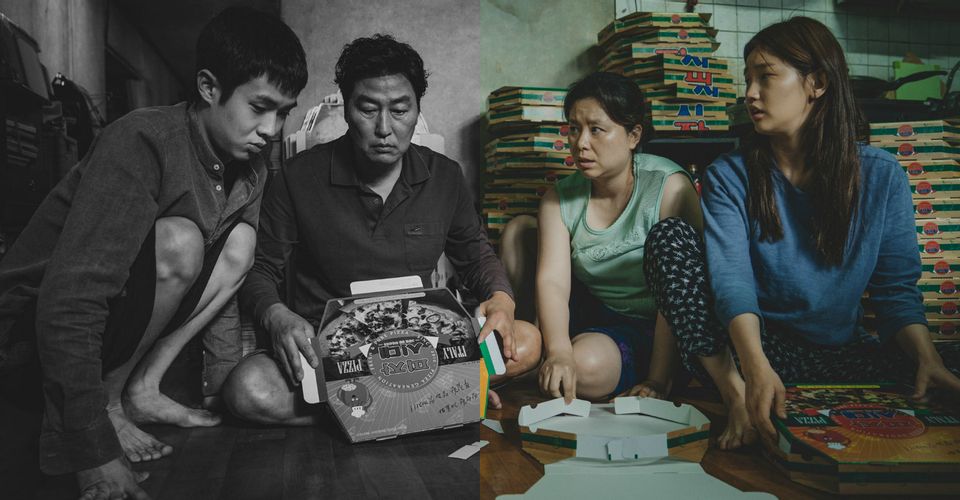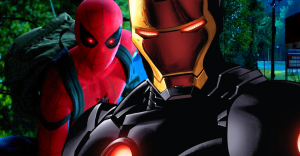Parasite’s Black & White Version Is Like Watching A Different Movie

Bong Joon-ho’s much-lauded Parasite has a black-and-white version, and it’s like watching an entirely different movie. In the months since it released, Bong Joon-ho’s masterful family drama has been enjoying a lot of success. Parasite swept the 2020 Oscars, including a remarkable Best Picture win; there have been talks of a HBO spin-off series, and the film has received a makeover with a monochromatic edition too. It is, of course, the same movie that picked up plenty of acclaim towards the end of last year. The only difference is that this version has been stripped of its color and the result is like watching a different movie entirely.
Parasite has become the landmark of Bong Joon-ho’s career thus far; considering some of his other efforts include Okja and Snowpiercer, it says a lot about how much audiences love his latest. The film recounts the story of the Kims – a poor, disheveled family – as they infiltrate a wealthier household, an impressive mansion belonging to the Park family. A lot of praise was given to Bong Joon-ho’s use of social commentary in Parasite, with the narrative acting as a fascinating microcosm for capitalism. But the film was great in so many other regards as well – the performances, the themes, the direction. One of Parasite‘s most memorable components was its beautiful cinematography and the use of luscious colors to add texture to its story. Naturally, a black-and-white rendition seems baffling at first. However, Bong Joon-ho and cinematographer Hong Kyung-pyo didn’t just remove the color from the frames; instead, they carefully regraded the whole film to work with its new monochromatic aesthetic. Despite being the same film, the new colorization changes how audiences will view the South Korean masterpiece.
The black-and-white version of Parasite first premiered at the Rotterdam film festival and has enjoyed some time on the festival circuit since. The film follows in the footsteps of Mad Max: Fury Road and Logan, which both received versions offering an altered color palette after their initial releases. Just like those versions, stripping the color doesn’t change the movie itself but, instead, it refines the experience and allows for a different perspective on a story you otherwise wouldn’t get with color. The same can be said for the new rendition of Parasite, which offers audiences the chance to view the film in a whole new light.
Parasite’s Black & White Version Changes How You Watch The Movie

Parasite in black & white offers a more focused viewing experience of the film. The reason for this is that much of the visual appeal has been stripped away; whilst the framework and shots are still impressively constructed, the lack of color allows viewers to spend less time soaking in the visual appeal and more time focusing on the rich characterization and subliminal writing. This, in turn, offers a more intimate experience with the Kim family. The monochromatic palette adds an intensity to the proceedings that elevates every scene, making their bad conditions feel even worse. It re-enforces the poor quality of life that they have when audiences first meet them tucked into their tiny apartment, with the black-and-white adding to the scuzzy, kitchen sink feeling of the Kim family home. This is because the lack of color forces the viewers to fill in blanks with their minds; seeing four characters cramped into a small, claustrophobic space makes audiences heighten the situation in their minds.
The same can be said when the narrative shifts focus into the Park mansion. Whilst some of the glamour and wealth of the manor is lost with the color, it feels grander in its sheer size. It becomes a monolithic entity as the colors fade together which gives it a life of its own and makes it feel somewhat more intimidating than it already was before. The texture is elaborated upon, so the clean surfaces feel shinier and richer in the same way the Kim family’s overflowing toilet looks even dirtier. Bong Joon-ho spoke about this when discussing the new cut with THR, how “we can focus more on the texture”. It allows for more distinction and emphasis on each family’s particular living situations – then adding to the overall intensity of the events that unfold.
The increased intensity in Parasite also extends into characterization and performance; Song Kang-ho’s incredible turn as Kim Ki-taek, the father of the Kim family, suddenly feels more anguished. The expressions become much more defined as a result of the re-colorization. Mr. Park’s disdain for his new employees is more prevalent. The sadness is enriched and the anger is heightened and you can feel a lot more of the emotion behind every character’s eyes. The contrast between clothing is also furthered due to the added texture as already mentioned. Mr. Park’s clothes look neater and more high-quality than the tackiness of Kevin or Jessica’s attire. Considering how much of the narrative relies on this class clash, these added details really make the disparity between the two families feel all the more defined. It pushes them even further apart, making the message hit harder and more enthralling.
Because of how much more investing the narrative becomes, audiences are able to appreciate more of these nuances. The script becomes so much richer as every word lingers that little bit longer; the jokes are funnier, the threats are more piercing. Taking away the color almost removes a barrier between audience and film and it’s suddenly a much more involving experience – with viewers allowed the opportunity to really soak in the subtleties of Bong Joon-ho’s writing and direction.
In his interview with THR, Bong Joon-ho revealed that part of the decision behind the black-and-white version of Parasite was to make his film feel classic in nature. He said, “I think it may be vanity on my part, but when I think of the classics, they’re all in black and white. So I had this idea that if I turned my films into black and white then they’d become classics”. The original cut of the film already feels so Hitchcockian in nature, with its twists and turns, and the desaturation only embellishes that idea further – putting his film in the same echelon visually now as well as thematically. The comparison to classical cinema is apt; people generally associate black-and-white movies to Hollywood of old so seeing a black-and-white film brings to mind classics the likes of Casablanca or Psycho. It makes Parasite feel timeless, just like those films are.
This also complements the themes of class, wealth, family, and gentrification at the core of Parasite superbly, considering they will always be timeless too. What is perhaps more noticeable, however, is how rooted in the modern world the narrative is. The use of technology and phones and contemporary architecture feels more prominent in this new cut; it provides a striking contrast between old and new that blends well with everything else the film has to say. In 10 years, this idea of contemporary versus classic will still be relevant and Parasite, through its black-and-white aesthetic, encapsulates it well. Given Parasite quickly became so beloved and widely-seen, classic status is very plausible. Only time will truly tell how much this is talked about in years to come, though the monochromatic look certainly goes a long way in making audiences feel like they’re watching something refined and old-school.
Rewatching Parasite Reveals More Clues (& Is A Great Experience)

Admittedly, Parasite doesn’t need a black-and-white version, in the same way that Logan, Mad Max: Fury Road, or even Bong Joon-ho’s Mother (which also got a similar treatment) don’t need it. Cinematographer Hong Kyung-pyo’s work is exceptional in the original cut and the colors are impeccably captured and should be admired. The film is great as it is. However, for the reasons mentioned already, there is a lot to be gained from watching the monochromatic take on the film. Whilst it can take away from some of the beauty, it’s almost like watching a different film. There are many new observations to be made and the themes can almost be appreciated a lot more as well. More clues are noticed too: how Mr. Park doesn’t like the smell of Mr. Kim, and subtle teases of the man in the basement, all become more apparent on rewatch. Knowing where the story is headed, it’s easier to see the breadcrumbs Bong Joon-ho lays out.
Of course, the main reason the black-and-white version of Parasite works as well as it does is because of the fact that you get the opportunity to watch Bong Joon-ho’s South Korean thriller again. It’s one of the best dramas in some time. Parasite is the rare film that becomes more rewarding the more you watch it; Bong Joon-ho has carefully layered his film and there are countless things to unpack from repeat viewings – in color or not. What the black-and-white edition of the film does offer is a chance to revisit that great story with its riveting writing, characters, and themes through a whole new lens to unpack it all in a different way. The narrative experience is the same – nothing has changed. That’s the beauty of Parasite in black-and-white; it may not be a new film, but the viewing experience will feel like it you’re watching something different.
- Parasite (2019)Release date: Nov 08, 2019
About The Author

















